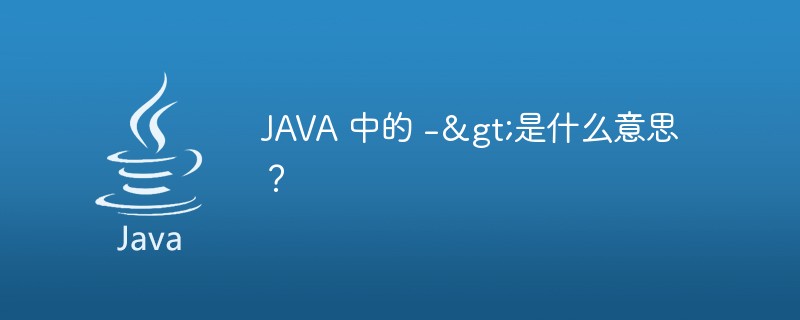Home >Java >javaTutorial >What does -> mean in JAVA?
What does -> mean in JAVA?
- 醉折花枝作酒筹forward
- 2021-04-28 09:11:585666browse
This article will introduce to you the meaning of "->" in JAVA. It has certain reference value. Friends in need can refer to it. I hope it will be helpful to everyone.

In "JAVA Core Programming", there is a piece of code like this
import javax.swing.*;
import java.awt.*;
import java.io.File;
public class ImageViewer {
public static void main(String[] args){
EventQueue.invokeLater(() -> {
JFrame frame = new ImageViewerFrame();
frame.setTitle("ImageViewer");
frame.setDefaultCloseOperation(JFrame.EXIT_ON_CLOSE);
frame.setVisible(true);
});
}
}
class ImageViewerFrame extends JFrame{
private JLabel label;
private JFileChooser chooser;
private static final int DEFAULT_WIDTH = 300;
private static final int DEFAULT_HEIGHT = 400;
public ImageViewerFrame(){
setSize(DEFAULT_WIDTH,DEFAULT_HEIGHT);
label = new JLabel();
add(label);
chooser = new JFileChooser();
chooser.setCurrentDirectory(new File("."));
JMenuBar menuBar = new JMenuBar();
setJMenuBar(menuBar);
JMenu menu = new JMenu();
menuBar.add(menu);
JMenuItem openItem = new JMenuItem("open");
menu.add(openItem);
openItem.addActionListener(Event -> {
int result = chooser.showOpenDialog(null);
if (result == JFileChooser.APPROVE_OPTION){
String name = chooser.getSelectedFile().getPath();
label.setIcon(new ImageIcon(name));
}
});
JMenuItem exitItem = new JMenuItem("exit");
menu.add(exitItem);
exitItem.addActionListener(Event -> System.exit(0));
}
}You can see two such codes
() -> {
JFrame frame = new ImageViewerFrame();
frame.setTitle("ImageViewer");
frame.setDefaultCloseOperation(JFrame.EXIT_ON_CLOSE);
frame.setVisible(true);
}Event -> {
int result = chooser.showOpenDialog(null);
if (result == JFileChooser.APPROVE_OPTION){
String name = chooser.getSelectedFile().getPath();
label.setIcon(new ImageIcon(name));
}Lambda expressions in Java 8. It's an anonymous function.
The above paragraph can be seen as follows:
EventQueue.invokeLater(new Runnable() {
public void run() {
JFrame frame = new ImageViewerFrame();
frame.setTitle("ImageViewer");
frame.setDefaultCloseOperation(JFrame.EXIT_ON_CLOSE);
frame.setVisible(true);
}
});The following paragraph can be seen as:
openItem.addActionListener(new ActionListener() {
public void actionPerformed(ActionEvent e) {
int result = chooser.showOpenDialog(null);
if (result == JFileChooser.APPROVE_OPTION){
String name = chooser.getSelectedFile().getPath();
label.setIcon(new ImageIcon(name));
}
}
});It’s just that java automatically translates it for you
Recommended : "java video tutorial"
The above is the detailed content of What does -> mean in JAVA?. For more information, please follow other related articles on the PHP Chinese website!
Statement:
This article is reproduced at:csdn.net. If there is any infringement, please contact admin@php.cn delete
Previous article:How JSch executes Shell commands remotelyNext article:How JSch executes Shell commands remotely

